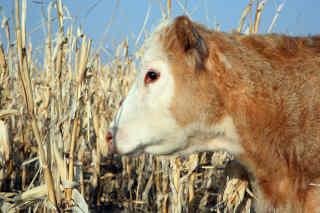By Ben Beckman
Grazing vs. Baling Corn Residues
As harvest progresses, crop residues are readily becoming available as a forage source. Producers looking to capitalize on these feeds often consider two options for use: grazing or baling. Which option is best for you?
Grazing corn residue allows animals to be selective about what they eat. Animals choose higher quality grain, leaf and husk first, grazing soiled or lower quality feed when it becomes the only choice available. With proper stocking, corn residues will meet nutrient requirements in dry cows. However, quality of residues will decrease with time as stalks are subjected to weathering.
Practices such as strip or rotational grazing can help extend the grazing period and balance quality. Initial investments in fence and water sources are drawbacks of grazing, but once the labor of putting fence in is completed, the cows do the work of harvesting.
Baling, on the other hand, requires labor and fuel to harvest and put-up residues. Because of the tough nature of corn residue, wear and tear on machinery is a consideration. How residues are harvested is also important and can greatly impact final quality. If the initial raking of residues is particularly aggressive, the dirt(ash) content of the final product will be high.
Because of the generally low quality and the risk of sorting, grinding cornstalk bales before feeding is beneficial. This does, however, add additional cost and equipment requirements for use.
Finally, baled residues are usually fed away from the field where they are harvested, resulting in nutrients losses where harvest occurred. The value of these losses depends on fertilizer price and how much residue is removed. Spreading manure from the feeding location back on the field can help mitigate some of this loss.
Grazing Standing Corn
Dry weather may have left your corn field with low yield. If harvesting for hay or silage did not occur, can we capture value in standing corn by grazing?

With careful management, grazing low-yielding corn can be a beneficial alternative to harvesting for hay or silage.
After a brief learning period, cattle in standing corn will preferentially graze corn ears if any have developed. Drought-damaged corn may not have many ears, but if much grain has developed, the cattle first need to adapt to a higher grain diet before grazing corn begins. Otherwise, acidosis or other digestive disorders could develop.
Cross-fencing and strip-grazing is needed to minimize trampling waste. Give cattle access to no more than a two-day supply of fresh corn at a time — a one-day supply is even better, especially for younger, growing cattle. Dry cows might do fine if moved just twice each week.
Dry cows may become fat and over-conditioned grazing standing corn, especially if grain is present. Even without grain, barren stalks can be surprisingly high in nutrient concentration because protein and energy that normally would have been transferred to the grain has instead been stored in the stalk and leaves. Diets containing crude protein exceeding 8% and TDN of 55% are usually expected.
Standing corn can be limit-fed to stretch the supply and/or to minimize over-conditioning by reducing the area allotted to the cows and forcing them to eat more of the lower-quality stalks. However, nitrate concentration may be high in the lower portion of the cornstalks. Before forcing animals to consume this part of the plant, test the stalks for nitrates and then manage accordingly.
Source : unl.edu